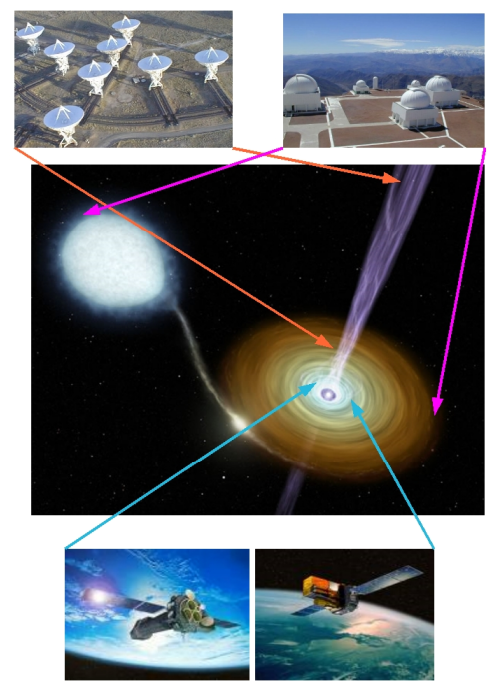|
PhD Student: Yoon Young Chun
Start Date: Sep 2009
End Date: Aug 2013 (last year funded out of non-EU sources)
Responsible Advisor: Emrah Kalemci (Sabanci)
Co-Advisors: Luciano Burderi (Cagliari), Stéphane Corbel (Saclay)  The hard state is perhaps the most complicated among the more persistent spectral states of black holes. Not only is it associated with emission from all three fundamental accretion components: the accretion disk, the hot accretion disk corona and the jet, but it also hosts very rich temporal variability properties (low frequency QPOs in the power density spectra, time lags, long time scale evolution). Decoding the interplay between the spectral and temporal components can provide invaluable clues for understanding the overall accretion geometry and system physics, and the aim of this PhD project is to understand the evolution of accretion components in the Hard State via multiwavelength data analysis. The hard state is perhaps the most complicated among the more persistent spectral states of black holes. Not only is it associated with emission from all three fundamental accretion components: the accretion disk, the hot accretion disk corona and the jet, but it also hosts very rich temporal variability properties (low frequency QPOs in the power density spectra, time lags, long time scale evolution). Decoding the interplay between the spectral and temporal components can provide invaluable clues for understanding the overall accretion geometry and system physics, and the aim of this PhD project is to understand the evolution of accretion components in the Hard State via multiwavelength data analysis.
Phenomenological spectral modeling of radio, IR and X-ray data for single sources, in combination with their variability properties, has already been carried out (Kalemci et al., 2005, 2006). What is still lacking is the development of a physical model which can actually account for the temporally evolving phenomena. Proprietary models developed by the members of the ITN (e.g., Markoff et al., 2005) are being further developed in order to be up to this task. In order to develop a self-consistent picture, we must understand the link between the inflowing plasma in the disk, and the outflowing plasma in the jet, as well as any disk winds. As shown in the figure, this can only be done with the analysis of quasi-simultaneous, multiwavelength data. Sabanci University is part of a multiwavelength program that has been very successful in obtaining observing times from satellites as well as ground-based optical, near-IR, and radio facilities. Using these data, the PhD student will focus on understanding the geometry of the hard state components, and other pressing questions about the system physics via a new combination of spectral modeling with temporal decomposition analysis.
The PhD program at Sabanci University lasts 3-4 years, and if necessary, the final year will be supported by funding external to the ITN. This project will use both archival and new data obtained through observing proposals written in part by the student. For short time scale analysis, power density and cross-spectral properties will be correlated against energy spectral properties, especially in combination with new jet models. Co-advisor Dr. Corbel is an expert on radio and X-ray observations of GBHs, and co-advisor Prof. Burderi is an expert on the broadband spectral analysis of compact objects and X-ray timing. They will both participate in the training of the student in data analysis techniques and interpretation. The student will also be instructed by Dr. Markoff and the researchers at University of Amsterdam in the use of the newly developed temporal jet models.
An overview talk on the current state of the project as presented at the Collaboration Meeting in September 2010 in Istanbul can be found here.
Related publicationsRefereed
- Chun, Y. Y., Dincer, T., Kalemci, E., Guver, T., Tomsick, J. A., Buxton, M. M., Brocksopp, C., Corbel, S., and Cabrera-Lavers, A., 2012, Multiwavelength Observations of the Black Hole Transient XTE J1752-223 during its 2010 Outburst Decay, ApJ, submitted (ADS-Entry)
Other
- Kalemci, E., Dinçer, T., Chun, Y. Y., Tomsick, J. A., and Buxton, M. M., 2012, Complete Multiwavelength Evolution of Black Hole Transients During Outburst Decay: Conditions for Jet Formation, in: , Half a Century of X-ray Astronomy (ADS-Entry)
- Kalemci, E., Chun, Y. Y., Dinçer, T., Buxton, M., Tomsick, J. A., Corbel, S., and Kaaret, P., 2011, Connections between jet formation and multiwavelength spectral evolution in black hole transients, in: Jets at all scales, Proc. IAU Symposium 275, 299 (ADS-Entry)
Fast Communications
none yet available
|



 The hard state is perhaps the most complicated among the more persistent spectral states of black holes. Not only is it associated with emission from all three fundamental accretion components: the accretion disk, the hot accretion disk corona and the jet, but it also hosts very rich temporal variability properties (low frequency QPOs in the power density spectra, time lags, long time scale evolution). Decoding the interplay between the spectral and temporal components can provide invaluable clues for understanding the overall accretion geometry and system physics, and the aim of this PhD project is to understand the evolution of accretion components in the Hard State via multiwavelength data analysis.
The hard state is perhaps the most complicated among the more persistent spectral states of black holes. Not only is it associated with emission from all three fundamental accretion components: the accretion disk, the hot accretion disk corona and the jet, but it also hosts very rich temporal variability properties (low frequency QPOs in the power density spectra, time lags, long time scale evolution). Decoding the interplay between the spectral and temporal components can provide invaluable clues for understanding the overall accretion geometry and system physics, and the aim of this PhD project is to understand the evolution of accretion components in the Hard State via multiwavelength data analysis.